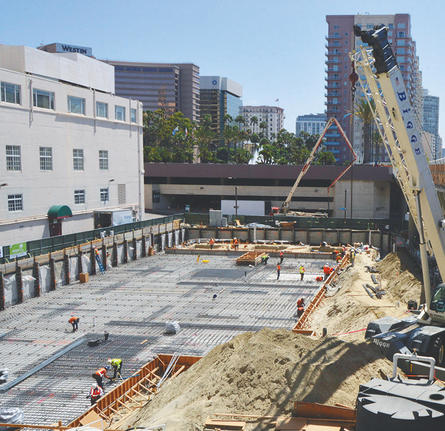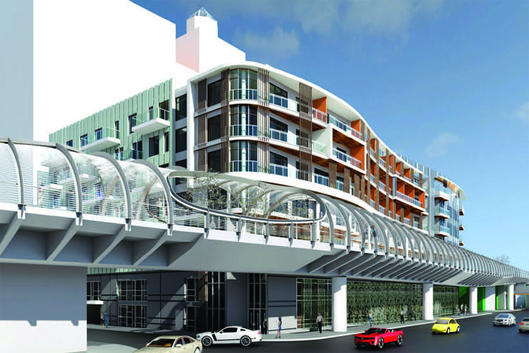Current trends in Long Beach’s residential and commercial real estate markets are remaining consistent with those of prior months, according to regional economists and local real estate professionals.
Much like the state, Long Beach continues to contend with a shortage in its housing supply, lacking the inventory to meet the needs of buyers, renters and investors. As a result, home prices continue to push upward. Still, those interviewed by the Business Journal view overall housing prices in Long Beach as affordable in comparison to other coastal cities in the region.

Ensemble Real Estate Investments’ Sonata Modern Flats is under construction at 207 E. Seaside Way, across the street from the Long Beach Convention & Entertainment Center. The project, expected to be completed late next year, includes 112 units for lease, a rooftop deck with a plunge pool, outside kitchen and lounge seating, fitness center and resident lounge. (Photograph by the Business Journal’s Larry Duncan)
“I think it’s still a place where you have this urban core with a reasonably open housing market,” Christopher Thornberg, founding partner of Beacon Economics, told the Business Journal. “I am being cautious there because, yes, there are issues with affordability in Long Beach. But relative to a lot of places along the coast, it is really pretty good,” he said.
Thornberg argued that the rhetoric surrounding the housing crisis in California has not been reflective of the true root issue. “To start with, I would argue that words matter. And the first thing that we need to stop doing is to stop calling this an affordability crisis. It’s a supply crisis,” he said. “And, of course, the reason that prices are going up is because of the fact that there is not enough supply.”
In California, active listings of single-family homes decreased by 13.5% from June 2016 to June 2017, according to the California Association of Realtors.
“Now, if you instead acknowledge that this is a supply problem first and foremost, that immediately forces us to take a step back and start thinking about, well, why don’t we have enough supply? Why don’t we build enough housing?” Thornberg said. “You have to start with this basic idea that it’s all these policies we have put into place that artificially restricts supply.”
Policies like the California Environmental Quality Act “empower every NIMBY [Not In My Backyard] to fight tooth and nail against everything and delay and hold back and create all sorts of fixed costs for every sort of development,” Thornberg argued. Additionally, he said, “Our zoning plans in Southern California are woefully behind the times.”
There are several multi-family developments underway in Long Beach, with many more planned. “There were 336 units permitted in the first quarter. Over the previous three years [there were] about 300,” Thornberg noted.
Petra Durnin, CBRE’s Southern California director of research and analysis, said via e-mail that these developments signal the strength of the multi-family market in Long Beach.
“Long Beach is an emerging live, work [and] play submarket, attracting people who want a unique living experience and less of a commute. Transit is improving and the amenity base is growing, which helps drive demand,” she said. “The City of Long Beach is also extremely pro-development, making it a logical choice for investors and developers.”
There is a shortage of existing multi-family properties for sale in Long Beach, according to local apartment specialists. They noted that strong market dynamics – low interest rates, low vacancy and increasing rents – make multi-family properties attractive investments. However, that is also part of the reason for low supply: owners are not incentivized to sell.
While the vacancy rate of the Long Beach office market remains in the double digits – about 14% – this is not unlike other cities in California, according to Thornberg. “It has to do with how office demand has shifted. Even in the Bay Area, which has got an incredibly tight office market, office vacancy rates are still in the double digits, believe it or not,” he said.
Workplace trends are shifting away from what existing office stock offers, Thornberg explained. “What is important for Long Beach is, as a city, to push hard in terms of making sure that the office stock is kind of in line with the current needs in the marketplace,” he said.
Durnin pointed out that the Silicon Beach area of Los Angeles County is nearing capacity, which should drive technology, media and entertainment firms to look for offices in other areas. “This is also evident in nearby San Pedro and will likely spill over in Long Beach in the future,” she noted.

A rendering depicts the future Sonata Modern Flats, which will connect to the soon to open Rainbow Bridge. Sonata’s “public spaces, retail and café seating will connect directly out onto the Rainbow Bridge in order to provide a focal point for the elevated park and give people a reason to stop, hang out and interact,” Ensemble’s Tyson Sayles said in a prepared statement. (Rendering provided by Ensemble)
Retail real estate, too, is being affected by changes in lifestyle – in this case, how people want to shop. But Thornberg advocated for caution in over-exaggerating impacts to the industry. “The reason I get upset about a lot of the press coverage on retail is it does seem to give you the impression that retail in general is just kind of imploding. And I don’t see that,” he said. “If I am looking at the marketplace, it is certainly shifting. But it’s shifting in very specific ways.”
Malls tend to have the sorts of stores that suffer from competition from the Internet, Thornberg observed. Plus, he said, “They are not very attractive. There is not a lot going on. The food tends to suck.”
Three types of retail should continue to thrive, according to Thornberg. “One is convenience retail, and that is just: I need it and I need it now. That’s just not going anywhere,” he said. “You have what I call destination retail, and that is retail attached to restaurants, movie theaters, really nice places to hang out. . . . Those places are busier than nobody’s business.”
Thornberg added, “And then there is the specialty retail – think supermarkets and dry cleaners. Stuff that is never really going to be replaced by the Internet, no matter how much Jeff Bezos [CEO of Amazon] wants us to buy food online. Me, personally, I want to squeeze my oranges before I buy them. And Jeff isn’t going to convince me otherwise.”
Durnin noted that Long Beach is home to a variety of eclectic retailers. “It has become a mecca for hip restaurants with numerous wildly popular dive bars along with craft cocktail taverns, vintage shops and boutiques,” she said.
While industrial real estate is in high demand in Long Beach, Durnin noted that low vacancy rates coupled with a lack of land to build on have caused prices to increase “to a point that precludes industrial product as the highest and best use for development.”
Local real estate professionals reported that industrial property rental and sales prices are increasing and that the vacancy rate of these properties is around 1%. “The industrial market is evolving in concert with retail to meet e-commerce needs. Long Beach is an infill market, which is a critical part of the last-mile requirements to get goods to consumers quickly and efficiently,” Durnin said.
Overall, Thornberg said Long Beach has some incredible real estate opportunities. “Really in so many ways, I think that Long Beach is going to be turning a corner in the next decade,” he said. “I think there are so many potential positive trends that are going to happen there because it’s such a great place and it’s such a great location.”
